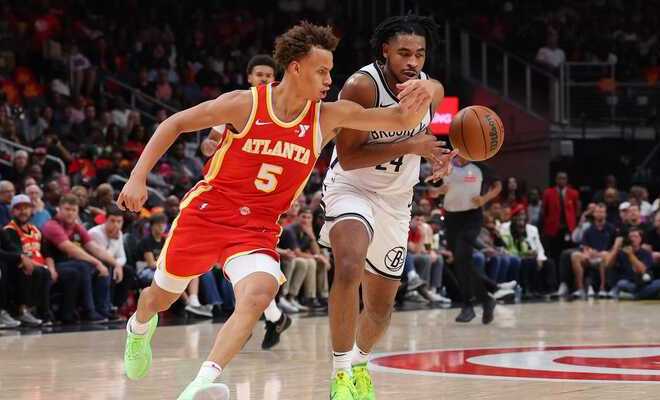-
 June 5, 2025, 7:45 pm
June 5, 2025, 7:45 pmLast Updated on June 5, 2025 7:45 pm by Keston Paul | Published: June 5, 2025
Most likely against their fans’ wishes, the Hawks have cemented themselves as Play-In mainstays. However, this season did feel different than the previous versions. An off-season trade of Dejounte Murray led to a visually different team, with younger players emerging and providing some optimism for internal growth down the road. Now with a more defined direction and less questions circulating around their key players, the Hawks will attempt to take the next step forward out of the Play-In race.
How’d It Go?
We could say the Hawks finished between 36 and 43 wins for the fifth consecutive season, or we could say the Hawks made some minor strides by improving from 36 wins to 40 wins. I prefer the latter due to the shakeup the team incurred in the off-season and semblances of a positive direction. At the end of the prior season, it became clear that a Trae Young and Dejounte Murray pairing was not yielding any desired results. Rather than try and make it work yet again between the two guards, the Hawks instead opted to trade away Murray and aim for a re-tool around Young. The main return of Dyson Daniels, Larry Nance Jr., a ’25 Lakers 1st-round pick, and a ’27 1st-round pick (apologies to E.J. Liddell and Cody Zeller for not making the cut) may have felt light after the team originally traded away Danilo Gallinari and three first-round picks to originally acquire Murray. However, the trade quickly looked shrewd as the season progressed.
With an expanded role and opportunity, Daniels ascended like a rocket to new defensive levels, powering his way to the Most Improved Player Award. He lived in passing lanes, helping push in transition and assist in masking the poor defense of Young. Jalen Johnson continued his emergence, displaying many of the all-around elements that led the Hawks to ink Johnson to a five-year, $150 million extension in the off-season. Onyeka Okongwu finally snatched the starting center role from Clint Capela, answering fantasy managers’ prayers for seasons and seasons. The addition of first-overall pick Zaccharie Risacher was a bit muddled but had enough promise to be a contributing member.
A constant issue persisted with the team however. Whenever Young was off the court, the offense cratered to a standstill. With only one real creation threat on offense, the Hawks struggled to threaten teams on a nightly basis, leading to inconsistent performances throughout the season. A trade deadline deal sending out De’Andre Hunter and receiving Caris LeVert, Georges Niang, and draft compensation was an attempt to fix this problem, but it didn’t fully work out. This has been the story of Young’s tenure on the team and a problem that no one has been able to solve. The Hawks could hope for internal improvement or bring in outside help to alleviate this issue. Either way, it needs to be solved for the Hawks to escape the Play-In doldrums.
Coaching
Quin Snyder entered his second full season as the Hawks head coach. Known as an offensive coach from his Utah Jazz days, the results for the Hawks have been mixed to say the best. The Jazz were are a sharpshooting team that weren’t afraid to launch threes, ranking towards the top of the league in three-point attempts in Snyder’s time there as head coach. The Hawks have yet to fully adopt Snyder’s principles, ranking 18th in the percentage of team shots as triples per CleaningTheGlass. Perhaps you could argue the personnel of the Hawks are not well-suited to this style, but that seems to go against Snyder’s offensive philosophy. The offense did look more free-flowing at times during the year, so maybe that is the silver lining here for the Hawks.
On the defensive end, it hasn’t come together. The Hawks have ranked in or near the bottom-third in defensive rating per CleaningTheGlass the last two seasons even though you could argue they have decent or strong defensive pieces across the roster. Snyder often seems to mismatch defensive schemes to his player’s skill sets, such as having Capela operate as a hedging and/or trapping big or running a non-switching system when players like Young or Georges Niang are on the court. Snyder most likely wasn’t hired to build a threatening defensive squad, but you would at least hope for a semblance of cohesion there. Maybe Snyder was fortunate he had Rudy Gobert anchoring his line-ups in his Jazz days, but that level of defensive player doesn’t exist on the Hawks. With some clarity on the full-time center in Okongwu and defined roles across positions, there is some optimism for the defensive flaws to be ironed out.
Snyder will be entering his third off-season as the Hawks coach. This is the time where you would expect his blueprints to be fully implemented, which hopefully will lead to some clearer improvements on both sides of the court.
The Players
Trae YoungPG, Atlanta HawksSeason Team GP GS MPG FGM FGA FG% FTM FTA FT% 3PTM 3PTA 3PT% PTS REB AST STL BLK TO 25-26 ATL 5 5 27.8 5.2 14.0 37.1 6.4 7.8 82.1 1.0 5.2 19.2 17.8 2.0 7.8 0.8 0.2 2.0 24-25 ATL 76 76 36.0 7.4 18.1 41.1 6.5 7.4 87.5 2.9 8.4 34.0 24.2 3.1 11.6 1.2 0.2 4.7 23-24 ATL 54 54 36.0 8.0 18.7 43.0 6.4 7.5 85.5 3.2 8.7 37.3 25.7 2.8 10.8 1.3 0.2 4.4 ADP: 12.4/16.8 (Yahoo/ESPN) | Total Value: 6/33 (8/9-cat) | Per-Game Value: 16/51 (8/9-cat)
With Dejounte Murray out of town, it placed much of the creation load onto Trae Young. He responded admirably with arguably the best passing season of his career, averaging a league-leading 11.6 assists per game. That was a full 1.4 assists more a game than the next leading player in Nikola Jokic. Some may complain about Young’s turnovers (an unsightly 4.7 a game and “league-leading”). That doesn’t factor in just how much Young had to do to help keep the offense afloat in his minutes. Young orchestrated the offense beautifully, dealing dimes to teammates left and right. From CleaningTheGlass, the Hawks shot 3.4% better in terms of eFG% when Young was on the court, one of the higher differences in the league. That is not a fluke, as Young creates such a high volume of great looks for his teammates.
If it isn’t clear by the above paragraph, I don’t hide that I respect Young’s game massively compared to what I believe to be the general public’s opinion. That doesn’t mean I’m blind to his flaws however. Although I’m tempted to fully hand-wave the turnovers away given his offensive load, it still is an aspect of his game he can improve upon. Additionally, Young’s field-goal percentage plunged to a career-worst 41.1%. You could say that would be expected with more shots with Murray out of town, but Young actually took fewer field goals per game than last season. I could cite the excuse that Young was dealing with a nagging sore Achilles throughout the majority of the season. As I said, that would mainly be an excuse. Young did visibly appear a bit slower and less agile, but he can’t be shooting the ball this poorly if the offense is to run smoothly.
Everything else was pretty standard for Young. His clear stat deficiencies prevent him from ever reaching first-round pick status. As evidenced by his 8-category totals ranking of sixth, he has a home as a second-round pick in punt builds.
Dyson DanielsPG, Atlanta HawksSeason Team GP GS MPG FGM FGA FG% FTM FTA FT% 3PTM 3PTA 3PT% PTS REB AST STL BLK TO 25-26 ATL 27 27 34.1 5.1 10.4 49.1 1.1 1.8 62.5 0.3 1.6 15.9 11.6 6.5 5.7 2.1 0.4 2.4 24-25 ATL 76 76 33.8 6.0 12.1 49.3 1.1 1.8 59.3 1.1 3.1 34.0 14.1 5.9 4.4 3.0 0.7 2.0 23-24 NO 61 16 22.3 2.3 5.1 44.7 0.6 0.9 64.2 0.7 2.2 31.1 5.8 3.9 2.7 1.4 0.4 1.0 ADP: 144.0/140.6 (Yahoo/ESPN) | Total Value: 11/7 (8/9-cat) | Per-Game Value: 21/14 (8/9-cat)
When Daniels was traded from the Pelicans to the Hawks, there was opportunity and optimism for the third-year guard. Could he finally emerge from the clutches of the Pelicans’ crowded rotation and finally see a consistent role? Daniels more than did that, becoming one of the best value picks in all of fantasy. You could say he “stole” (sorry not sorry) his way into all of our hearts with his rise. With his play, Daniels earned Most Improved Player and All-Defensive 1st Team honors while also being a finalist for Defensive Player of the Year.
How did Daniels transform himself from a late-round sleeper to a bonafide fantasy stud? Look no further than his steals. His 3.0 steals a game lapped the field, and Daniels became the first player to average at least 3.0 steals a game since Alvin Robertson in the 1990-91 season. If you are the first player to accomplish something in 30-plus seasons, you’re probably doing something right. Daniels didn’t just stop there. He made some great strides in his scoring efficiency, increasing his field-goal percentage to 49.3% while upping his usage to 18.2%. Increasing those two facets while seeing a minutes increase to 33.8 a game is no easy feat, and something that we should applaud Daniels for doing.
Daniels was also a solid connective player on offense. While he could struggle as the primary offensive engine, he found more success operating as a secondary creator. Daniels could take advantage of those openings when the defense was churned and then drive and attack the gaps. That leads into where Daniels can improve from here. The gain in his offensive involvement was notable, but 18.2% usage is still fairly low. If Daniels can continue to improve his dribbling and his shot so teams have to respect him more, that will open up additional avenues for others and himself. The ceiling for Daniels isn’t set in stone yet, and managers can expect a full complement of production heading into next season. Daniels is much more valuable than just a typical steals specialist.
Want access to the rest of this Season Wrap? You’ll need to have a FANTASYPASS membership. Click here to learn more and sign up!
